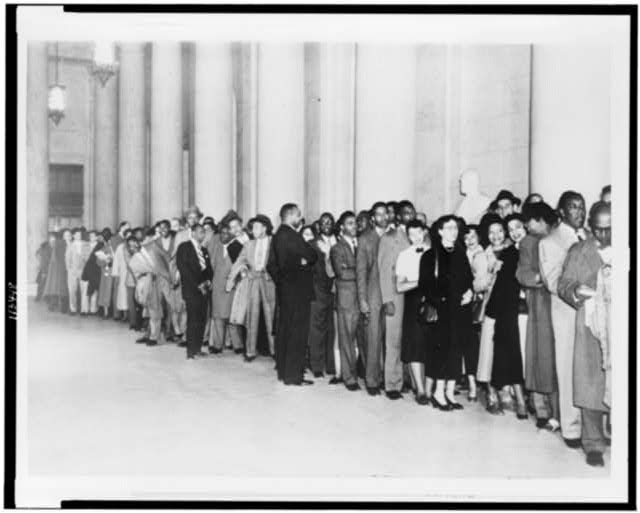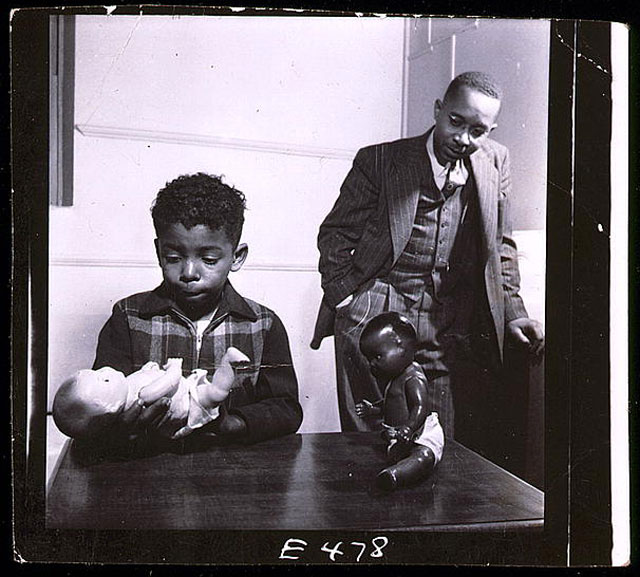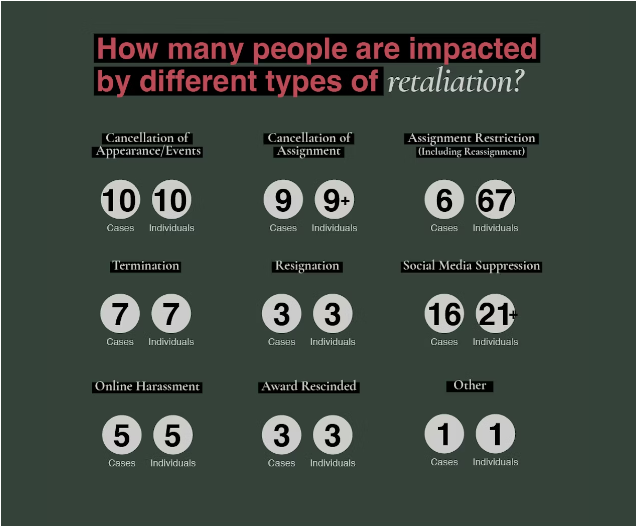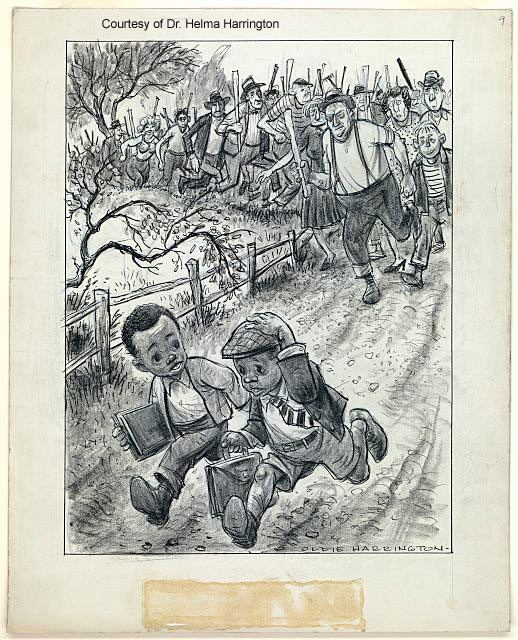Promise of Brown Decision Has Always Fallen Short
Tribute to Black Working Class Wins RFK Award
Group Finds Pro-Palestinian Writers Penalized
CNN Not Saying How It Obtained Video of Combs
Linsey Davis to Co-Moderate ABC’s Biden-Trump Debate
At 69, Gayle King Makes SI’s Swimsuit Cover
Longtime Telemundo Reporter Fernando Mejia Let Go
Latino News Consumers Seek Language Diversity
Police Ignore Warnings on Handcuffing Facedown
. . . When Inmates Given Dangerous Jobs Are Killed
‘What the Black Twitter Docuseries Gets Wrong’
Guatemala’s Zamora One Step Closer to Freedom
Press-Freedom Groups Decry Inaction on 2022 Killing
(more to come)
Homepage photo: Oliver W. Harrington (1912–1995). Dark laughter. Now I aint so sure I wanna get educated, 1963. Published in the Pittsburgh Courier, September 21, 1963. Prints and Photographs Division, Library of Congress. Courtesy of Dr. Helma Harrington.
Support Journal-ismsDonations are tax-deductible.
Geoff Bennett reports on “The lasting legacy of Brown v. Board and ongoing education challenges” Friday on the “PBS NewsHour.” (Credit: YouTube)
Promise of Brown Decision Has Always Fallen Short
“Nearly 7 in 10 Americans say more should be done to integrate schools across the nation — a figure that has steadily climbed from 30 percent in 1973 and is now at its apex,” Laura Meckler, Emily Guskin and Scott Clement wrote Friday for The Washington Post. It was the day the nation marked the 70th anniversary of the historic Brown v. Board of Education school desegregation case.
“But a deeper look into the views of both Black and White people shows skepticism about the success of Brown and mixed messages about how to move forward,” the reporters continued.
“In its unanimous decision in Brown, the Supreme Court ruled segregated schools were unconstitutional and ‘inherently unequal,’ combining five cases in which Black students and their schools had far fewer resources than their White peers — longer commutes, lower-quality classes, overcrowding, fewer opportunities and less money. Yet 1 in 3 Black Americans now say integration has failed to improve the education of Black students, a companion Post-Ipsos survey of Black Americans finds. . . .”
The consensus among those reporting on Brown’s 70th anniversary is that its promise has yet to be realized. The remembrance comes as the forces against diversity, equity and inclusion are gaining steam, and students of color have yet to gain parity with whites.
The Chronicle of Higher Education reports that as of Thursday, 85 bills in 28 states and the U.S. Congress would prohibit colleges from having diversity, equity, and inclusion offices or staff; ban mandatory diversity training; forbid institutions to use diversity statements in hiring and promotion; or bar colleges from considering race, sex, ethnicity, or national origin in admissions or employment. Fourteen have final legislative approval, 14 have become law, and 47 have been tabled, failed to pass, or vetoed.
“ ‘We’ve come a long way since the Supreme Court ruled that school segregation was unconstitutional,’ House Minority Leader Hakeem Jeffries (D-N.Y.) told The Hill in a statement,” Cheyanne M. Daniels reported Saturday for The Hill. “ ‘But today, the most segregated school systems in America can be directly traced to policies put in place in the aftermath of Brown v. Board of Education,’ ” Jeffries continued.
“Though segregation is illegal, our schools still remain segregated today,” Jalisa Evans, chief executive officer and founder of The Black Educator Advocates Network, said in Daniels’ story. “As white students fled school districts to avoid integration, redlining continued to create segregated schools through housing. Today, schools with large numbers of Black students are underfunded.”
The San Antonio Express-News editorialized Thursday, “Seventy years after Brown, the nation is more diverse, yet, according to the Government Accountability Office, more than 18.5 million students, or more than one-third of K-12 public school students, attend schools where 75% or more of the students are of the same race or ethnicity.
“Seventy years after Brown, can we honestly say that every child is getting the quality education they deserve?
“Honesty compels us to answer no and rededicate ourselves to that goal.”

Waiting for courtroom seats, 1953. (Credit: New York World-Telegram & Sun Collection, Prints and Photographs Division, Library of Congress)
Annie Ma wrote Wednesday, updated Monday, for the Associated Press under the headline, “70 years ago, school integration was a dream many believed could actually happen. It hasn’t.“
Newspapers are relatively dispassionate about Brown today, a far cry from how many viewed the court decision when it was issued in 1954. And it’s not the first time Brown’s promise did not live up to expectations.
“It’s impossible to make young people understand the electric hope that seized us after Brown v. Board of Education ended the Jim Crow age,” Ebony and Jet publisher John H. Johnson wrote, with Lerone Bennett Jr., in his 1989 memoir, “Succeeding Against the Odds.“
“I remember thinking at the time, and I was not alone, that we were free at last and that the struggle would be over.”
According to Fred Carroll, in his 2017 book “Race News: Black Journalists and the Fight for Racial Justice in the Twentieth Century,” because of the Brown decision, “America’s racial problems emerged as a prominent national story. . . . News coverage expanded one year later when the justices equivocated on the pace of integration, giving segregationists the latitude they needed to stall. Delay, protest and violence ensued, compelling white journalists and broadcasters to devote more attention to racial unrest.”
Did the increased coverage mean a more humanizing, three-dimensional reporting of Black people? Not according to Aniko Bodroghkozy, author of “Equal Time: Television and the Civil Rights Movement,” published in 2012.
Bodroghkozy wrote, “While news coverage took a generally sympathetic stance toward the idea of desegregation, especially with regard to the Supreme Court’s Brown vs. Board of Education ruling and to voting rights, television news during this period [1957-1962] generally did not constitute a cheering section for the civil rights movement.
“Close textual and thematic analysis reveals that, in general, network news shows at the time told a story of sectional reconciliation around a constructed figure of the Southern white moderate. Southern blacks typically appeared as sympathetic but objectified figures rather than subjects in their own empowerment struggle.”
Nevertheless, Southern white journalists who were on the right side of history deserve their due.
Harry Ashmore, a rare white liberal Southern newspaper editor, who led the Charlotte (N.C.) News, assembled a team of journalists in 1954 to create the Southern Education Reporting Services. Its purpose, Gene Roberts and Hank Klibanoff wrote in their Pulitzer Prize-winning “The Race Beat: The Press, the Civil Rights Struggle and the Awakening of a Nation,” was to publish Southern School News, “a monthly, regionwide newspaper that would be a reliable source of fair, objective, in-depth, statistically reported information about the way school districts in the South were responding to desegregation orders. “
Its integrated board included P.B. Young, editor of the Black newspaper the Norfolk (Va.) Journal and Guide, who “embraced school desegregation only lightly, worrying that neither Negroes nor whites were ready for integration, that integration might lead to closing Negro schools and firing Negro teachers, and that white families would abandon public schools.” Some of his fears came true.
Ashmore also headed a 42-member team working on a book project, “The Negro and the Schools.”

In the “doll test,” psychologists Kenneth and Mamie Clark used four plastic, diaper-clad dolls, identical except for color. They showed the dolls to black children between the ages of three and seven and asked them questions to determine racial perception and preference. Almost all of the children readily identified the race of the dolls. However, when asked which they preferred, the majority selected the white doll and attributed positive characteristics to it. (Credit: Gordon Parks, 1947/ Prints and Photographs Division, Library of Congress)
Less than 24 hours after the book was published, on May 16, 1954, the Supreme Court issued its initial Brown decision. At first, white editorial reaction was muted. “We in the South were living then in a sort of postoperative shock; nobody was very mad about anything,” said James J. Kilpatrick, the segregation-supporting editor of the Richmond (Va.) News Leader, later well-known as a commentator. “It wasn’t until the following summer that the anesthesia wore off.”
Soon (White) Citizens Councils formed. Kilpatrick wrote of the high court, “These nine men repudiated the law of this land to suit their own gauzy concepts of sociology. If it be said now that the South is flouting the law, let it be said to the high court: You taught us how.”
Resistance was most strident in Mississippi, Virginia and South Carolina, Roberts and Klibanoff write. “Make a prompt and reasonable start toward full compliance? ‘It won’t happen in Mississippi,’ wrote the Jackson Daily News. ‘We are slow starters,” and this is one time that we won’t start at all. . . .”
Those standing for integration included Hodding Carter Jr. of the Delta Democrat-Times in Greenville, Miss., Ralph McGill, publisher of the Atlanta Constitution and Buford Boone, editor of the Tuscaloosa News in Alabama.
Still, “the councils and their like had found solid footing across the South — due in part to newspapers and local television stations that threw their full editorial weight behind them,” Roberts and Klibanoff write, “but due in greater part to a larger number of quiescent editors who failed to take a stand against them.”
- Lily Altavena, Detroit Free Press for Education Writers Association: Covering Civil Rights in Education From a Historical and Current Lens (June 27, 2023)
- John Celestand, Word In Black: Stop Asking Black Student-Athletes to Fix America’s DEI Mess
- Francesca Chambers, USA Today: In a nod to history, Biden meets with Brown v. Board of Education families
- Ronald Claiborne, Second Acts: 70 Years After School Segregation Was Declared Illegal, It’s Back
- Cheyanne M. Daniels, The Hill: ‘Shadow of segregation looms’ on 70th anniversary of Brown v. Board
- Editorial, Austin (Texas) American-Statesman: The harsh consequences of the Texas GOP’s fervor to crush DEI at UT (April 4)
- Editorial, San Antonio Express-News: 70 years after Brown, are children getting the education they deserve?
- Aaron Foley, New York Amsterdam News: Promise of Brown v. Board of Education not reaching NYC’s migrant students
- Glenn Gamboa, Associated Press: The larger the nonprofit, the more likely it is run by a white man, says new Candid diversity report
- Government Accountability Office: K-12 Education: Student Population Has Significantly Diversified, but Many Schools Remain Divided Along Racial, Ethnic, and Economic Lines (June 16, 2022)
- Jennifer Berry Hawes, ProPublica: Segregation Academies Still Operate Across the South. One Town Grapples With Its Divided Schools.
- Jonah McKeown, Catholic News Agency: Catholic radio stations push back on new race and gender reporting rules (May 8)
- Cheyanne Mumphrey and Kimberlee Kruesi, Associated Press: Even with school choice, some Black families find options lacking decades after Brown v. Board
- Clarence Page, Chicago Tribune: DEI on campus and in corporations is due for a change (May 13)
- Makiya Seminera, Associated Press: UNC board slashes diversity program funding to divert money to public safety resources (May 13)
- Aziah Siid with Camika Royal, Ph.D, Sharif El Mekki, Kelly Hurst, EdD, and Dr. Gary Orfield, Ph.D, Word In Black: Watch: Brown at 70—A Reality Check on School Segregation
- Aswad Walker, Houston Defender: Here’s a Sure-Fire Way to End DEI, CRT Attacks at Colleges (May 8)
- Aswad Walker, Houston Defender: Black College-Bound High School Seniors Face New Post-DEI Hurdles (May 7)
- K.J. Yossman, Variety: BBC’s Former Creative Diversity Head Joanna Abeyie Speaks Out: ‘A Psychologically Safe Working Environment is Crucial’ (May 13)
Blair L.M. Kelley discussed her book “Black Folk” last year as it was about to be published. (Credit: YouTube)
Tribute to Black Working Class Wins RFK Award
A tribute to the Black working class — a group undercovered by the news media — was presented the Book Award Tuesday as Robert F. Kennedy Human Rights announced the winners of its 2024 RFK Book and Journalism Awards.
The livestreamed celebration of journalism covering social justice and human rights addressed a wide array of issues that deserve media attention. The honors applauded those who are doing such work, including student journalists in high school and college.
In fact, the Grand Prize Winner was Carnegie-Knight News21, housed at Arizona State University, which won the College Journalism Award for its project “America After Roe.”
Featuring the work of 25 student journalists from nine universities, “the project examines how the monumental decision has gone beyond abortion bans and courthouse battles to more broadly affect health care, culture, policy, and people,” the RFK organization said.
Students at Naperville Central High School in Naperville, Ill., won for “The hidden homeless: Thousands of schools are failing to identify students experiencing homelessness.”
“The reasons for the routine under-identification of youth experiencing homelessness involve a population so hidden it’s often forgotten, laws so unknown few know how to access help, and non-existent enforcement that allows those responsible for implementing the law to cut corners,” the Naperville students wrote for their newspaper, the Central Times.
African Americans were well-represented among the judges and presenters, though not so much among the winners, an observation also made in this space in 2005, but the book award winner was “Black Folk: The Roots of the Black Working Class” by historian Blair L.M. Kelley.
“Spanning two hundred years, ‘Black Folk’ highlights the lives of the laundresses, Pullman porters, domestic maids, and postal workers who established the Black working class as a force in the late nineteenth and early twentieth centuries. Kelley weaves her ancestors’ story into the history, adding a personal, moving, and very human narrative,” the RFK group said.
In addition, Washington Post photographer Jahi Chikwendiu, a Black journalist, followed his instincts and won an award for a project on Black maternal mortality.
Still, the subjects, like the need for social justice, touched nearly all ethnic groups.
Accepting her award, Kelley, director of the Center for the Study of the American South at the University of North Carolina, Chapel Hill, said, “this is a tribute to the Black working class, at a moment when the [importance] of Black history is being questioned.” She added on X, it’s “good to be recognized for work that reminds us why the past matters.”
Robert F. Kennedy Jr., whose family members have distanced themselves from his independent presidential candidacy, was not present.

(Credit: National Writers Union)
Group Finds Pro-Palestinian Writers Penalized
“In the months since October 7, Western media workers have faced a wave of retaliation for speaking up against or critically covering Israel’s war on Gaza — and in particular, for voicing support for Palestinians,” the National Writers Union declared May 6, following the May 3 World Press Freedom Day.
“In an effort to better understand the power dynamics and mechanisms behind the phenomenon, the National Writers Union tracked 44 cases of retaliation that impacted more than 100 media workers, who are disproportionately people of color.
“Since Hamas’s attack on October 7 and Israel’s subsequent military operations in Gaza, leaders of Western media companies and cultural institutions have acted to suppress the speech of media workers who seek to elevate Palestinian voices or express concern about Israel’s human rights violations. The National Writers Union (NWU) has compiled and verified 44 cases of retaliation that occurred between October 7, 2023 and February 1, 2024, which have affected more than 100 people.
“The authors of this report define retaliation as any action taken by a venue, outlet, organization, or group that has negatively affected a media worker, and that was triggered by a perception that the worker’s speech and/or actions supported the Palestinian cause or criticized the government of Israel. Retaliatory action, as we define it, can come from leaders inside the workplace or from outside individuals or interest groups. These cases are particularly concerning in the context of intensifying retaliation beyond the media industry — whether in the form of institutionally condoned harassment, mass arrests, or legislative pushes that could criminalize criticism of Israel.
“The data collected by NWU suggests that this retaliation has disproportionately targeted media workers of color, particularly workers of Middle Eastern or North African descent and those who identify as Muslim Three quarters of the cases where detailed demographic data was available involved people of color or Latinx people. More than a third of the targets of retaliation were Muslims or people of Middle Eastern or North African descent. These findings suggest that newsrooms’ grand gestures toward diversity, equity, and inclusion in recent years — especially since the police killing of George Floyd in 2020 — have fallen short in this ongoing crisis or were superficial all along. . . . “
As of May 21, preliminary investigations by the Committee to Protect Journalists showed at least 105 journalists and media workers were among the more than 36,000 killed since the war began on October 7 — with more than 35,000 Palestinian deaths in Gaza and the West Bank and 1,200 deaths in Israel.
- Oliver Darcy, CNN: Israel’s seizure of AP equipment shows its hostile posture toward the free press (May 22)
- Josef Federman and Danica Kirka, Associated Press: Israel says it will return video equipment seized from AP
Ed Laskos reports on the bombshell video for KTTV in Los Angeles. (Credit: YouTube)
CNN Not Saying How It Obtained Video of Combs
“Almost 48 hours after being shown physically assaulting his then-girlfriend Cassie Ventura in 2016 in a surveillance video obtained exclusively by CNN, Sean ‘Diddy’ Combs has apologized,” Alli Rosenbloom and Elizabeth Wagmeister reported Sunday for CNN.
“Just before 1pm ET on Friday, CNN published the video in which Combs is seen grabbing, shoving, dragging and kicking Ventura during an altercation that matches allegations in a now-settled federal lawsuit filed by Ventura in November. At publication time, representatives for Combs, an influential figure in the music industry who founded the music label Bad Boy in 1993, had not responded to requests for comment.
“Combs, a rapper, producer and business mogul, was silent for nearly two days as backlash mounted – including in the comments section of his old social media posts – and a media storm swirled. . . .”
CNN did not say how it obtained the video, but did report, “On Friday, CNN published surveillance video compiled from multiple camera angles dated March 5, 2016 that appeared to show . . . Combs during the 2016 incident at the InterContinental Hotel in Century City that was mentioned in Ventura’s complaint.
“CNN verified the location based on publicly available photos of the former hotel’s interior. . . .”
On The Root Monday, Tatsha Robertson and Biba Adams wrote, “Truth be told, nobody should give a rip about who leaked the video. The question really should not be why now, but why did it take so damn long?”. They then explored various possibilities.
CNN continued, “Ventura received an outpouring of support on social media in the days that followed the release of the video, with many highlighting Ventura’s story as a way to support other victims of domestic violence. . . .
“Following the release of the video, the Los Angeles County District Attorney’s Office issued a statement saying it was ‘aware of the video that has been circulating online allegedly depicting Sean Combs assaulting a young woman in Los Angeles.’
“ ‘We find the images extremely disturbing and difficult to watch,’ the statement posted on Instagram reads. ‘If the conduct depicted occurred in 2016, unfortunately we would be unable to charge as the conduct would have occurred beyond the timeline where a crime of assault can be prosecuted. As of today, law enforcement has not presented a case related to the attack depicted in the video against Mr. Combs, but we encourage anyone who has been a victim or witness to a crime to report it to law enforcement or reach out to our office for support from our Bureau of Victims Services,’ the district attorney’s office said.
“Just after 11am ET on Sunday, Combs released a video on Instagram, in which he apologized for an incident he’d previously denied ever happening in the first place. . . .”
- Travis M. Andrews, Anne Branigin, Helena Andrews-Dyer and Samantha Chery, Washington Post: The dark side of Diddy’s American Dream
- Jennifer R. Farmer, NewsOne: What Cassie Experienced Being Abused By Diddy Is Not An Anomaly
- Stephanie Holland, The Root: These Black Celebs Call Out Diddy for Shocking Video of Him Abusing Cassie (24 slides)
- William Ketchum III, The Root: Diddy has apologized, and Black Twitter has lots to say about it
- Njera Perkins, People: Sean ‘Diddy’ Combs Allegedly Paid $50K to Obtain Hotel Security Footage of Cassie Assault: Lawsuit
- Emily Rahhal and Hazel Sanchez, WPIX-TV, New York: Mayor Adams considering revoking Diddy’s key to NYC after ‘chilling’ video
- Alli Rosenbloom and Elizabeth Wagmeister, CNN: From denial to admission: How a surveillance tape held Sean ‘Diddy’ Combs accountable
- Dustin J. Seibert, HuffPost: Sean Combs, Russell Simmons And The Reckoning Of Men In Hip-Hop (April 10)
Bruce T. Wright wrote of Linsey Davis for NewsOne in 2019, “Davis’ line of questioning helped shine a light on two very key issues that Black voters, in particular, have been wanting to hear more about. And being that the setting of the debate was at the historically Black college of [Texas] Southern University in Houston, Davis’ questions were beyond appropriate and asked in the most professional of manners.” (Credit: YouTube)
Linsey Davis to Co-Moderate Biden-Trump Debate
Linsey Davis, an anchor for “ABC News Live Prime,” its streaming evening newscast, and of “World News Tonight” on Sundays has been chosen to co-moderate the debate between President Biden and former president Donald Trump in September, ABC said Wednesday. David Muir, anchor of “World News Tonight,” is the other co-moderator.
Neither has moderated a general-election presidential debate.
Davis is a correspondent filing reports for “World News Tonight,” “Good Morning America,” “20/20” and “Nightline.”
At a debate among Democratic presidential hopefuls in 2019, held at Texas Southern University in Houston, Davis asked, “Since we’re here at an HBCU, I’d like to start with young Black voters. Several recent polls indicate their number-one concern is racism. This campus, this state, and this nation are still raw from that racially motivated attack on Latinos in El Paso.
“Now, we know that the racial divide started long before President Trump and President Obama, but each of you on this stage has said that President Trump has made that divide worse. Congressman [Beto] O’Rourke, coming to you first, why are you the most qualified candidate to address this divide?” Davis also addressed the question to the other candidates.
On Feb. 1, 2021, when Davis was named co-anchor of “World News Tonight,” she told colleagues, “We are certainly kicking off Black History Month with a bang. Because today I’m mindful of Carole Simpson, and the decision that Roone Arledge made back in 1988, to promote her to the anchor of weekend World News Tonight and in doing so catapulted her into the history books as the first Black woman to helm any major network national newscast.
“And now three decades later she has the distinction of being as our Vice President would say, the first but not the last.”
- ABC News: Linsey Davis bio
- ABC News: Linsey Davis uncovers family story of enslavement to empowerment (video)
- Crystal Hill, Yahoo: Deborah Roberts, Kristen Welker and their Black female peers are more visible than ever on TV news. Why experts say this isn’t just ‘a moment.’ (Sept. 26)
- Ted Johnson, Deadline: CNN Says It Will Make Presidential Debate Available For Simulcast On Other Networks
- Tessa Stuart, Ryan Bort, Tim Dickinson, Patrick Reis, Rolling Stone: The Big Moments from the Third Democratic Debate The third Democratic presidential debate in Houston was… really quite good (Sept. 13, 2019)

“I wasn’t bothered by things like dimples, I don’t have hangups about my age,” Gayle King said, according to Elizabeth Paton, writing in The New York Times. “But the yellow swimsuit was ‘a little too boobalicious,’ as she put it, so she suggested retouching the photo to show less skin. ‘I love tasteful cleavage,’ Ms. King said. ‘But I didn’t want it to look like I was trying to flash people.‘ “
At 69, Gayle King Makes SI’s Swimsuit Cover
“Move over Martha Stewart! Gayle King is the latest senior citizen gracing the cover of the Sports Illustrated Swimsuit Issue,” Karu F. Daniels wrote May 14, updated May 15, for the Daily News in New York.
“The 69-year-old ‘CBS Mornings’ co-anchor joins models Kate Upton, Hunter McGrady and Chrissy Teigen for four separate covers of the magazine, which hits newsstands Friday.
“More than 20 other models, including Stewart, Tyra Banks, Winnie Harlow, Christie Brinkley and the magazine’s first transgender cover model Leyna Bloom, celebrate the edition’s 60th anniversary on three special ‘Legends’ covers. . . .”
Elizabeth Paton added Wednesday in The New York Times, ” ‘I didn’t want to look foolish or like I was trying too hard, but I did think it could be fun,’ Ms. King said. She received further encouragement from her ‘kitchen cabinet’ — her children, Kirby Bumpus and William Bumpus Jr., and her longtime best friend, Oprah Winfrey, who, Ms. King said jokingly, ‘pointed out that the two of us often have quite different ideas of fun.’ . . . ”
A year ago, media mogul Byron Allen presented King with the Grio’s “Icon Award” at an after-party in Washington following the White House Correspondents’ Dinner.
King told the crowd that she lived by advice she had been given: “Excellence is the best deterrent to racism.” She said that she didn’t like being called an icon, because it made her feel old. At 68, King said, “I’m not even thinking about retirement” and she is “looking for more things to do.” This, when Walter Cronkite, the legendary “CBS Evening News” anchor, was made to retire at 65.
- Kaelin Dodge, InStyle: Gayle King’s Sports Illustrated Swimsuit Featured the Detail Shoppers Call “Incredibly Flattering” Story

(Credit: Facebook)
Longtime Telemundo Reporter Fernando Mejia Let Go
“Fernando Mejía has left Noticiero Telemundo 39 KXTX Dallas – Fort Worth after nearly 15 years,” television news blogger Mike McGuff reported Thursday.
“Mejía has been the head of video journalists at Noticiero Telemundo 39 since October 2009. He is also a Telemundo University faculty member who has trained MMJs at the University of Texas at Arlington and the University of Florida.
“He previously worked for the Telemundo network after a 16-year tenure as a cameraman, editor, and reporter for the national edition of Noticiero Telemundo.”
A friend, Carlos Quintanilla, led what he described as a small protest at the station, and said he plans to return. He wrote on Facebook, “Yesterday they saw and continue to see the attitude of Teñemundo and how they treat people who question their treatment of an employee of more than 31 years. That attitude we expect from an anti-Hispanic TV station that doesn’t care about our community. I expected more from Telemundo and I was disappointed.”
Telemundo spokesperson Brian Potter said Tuesday, “We have nothing to share on this matter.”

“Lack of quality translation, coupled with a lack of holistic representation, pushes community members away from traditional media outlets for news.”
Latino News Consumers Seek Language Diversity
With reporting often published in English, many local papers are inaccessible to recent immigrants and communities that speak English as a second language, Chloe Nguyen wrote Wednesday for the Poynter Institute.
“Where do these communities turn for news instead?
“While working last fall as a Poynter-Google News Initiative misinformation student fellow for WRAL-TV in North Carolina, I sought to answer this question for the largest language minority group in the state: Hispanic communities.
“Without a newspaper in their first or preferred language, many minority communities struggle to access essential local news from traditional media outlets, including information about vaccine clinics, or extreme weather warnings. WRAL-TV sought to understand how they could improve the reach of their coverage for these communities.
“We created two surveys — one in English and one in Spanish — consisting of questions that would help us study these topics. After standing in front of grocery stores, hanging up flyers in restaurants with my friends, and networking through community organizations, we received 26 responses over about a month and a half. We supplemented our findings with interviews with two community leaders whose experience working in local journalism and with community members strengthened our analysis.
“Consistent with national research on the news consumption habits of Latino communities, our survey revealed that local Hispanic residents rely predominantly on social media for news, followed by television and websites. Sparse translation, coupled with inadequate representation, creates barriers to news access and may drive distrust in English-language news organizations for Hispanics.
“Discussing translation, respondents lamented that there are few attempts at translation of local news into Spanish. When it is translated, the translations are often sensationalist and inaccurate. As one respondent summarized:
“ ‘The American media does little to address the realities that affect Hispanic families. There is not enough translation and, sadly, many attempts lack quality because they translate very poorly and I end up uninformed.’
“This lack of quality translation, coupled with a lack of holistic representation, pushes community members away from traditional media outlets for news. Community members also felt as if most English-language coverage of their community was negative, focusing on crime rather than community activities and businesses. Again, these limitations may undermine community trust in English news outlets in North Carolina.
“Spanish speakers are more trusting of Spanish-language news, and some research finds that community members who receive their news from ethnic media outlets — outlets covering underrepresented communities like the Hispanic community — are more likely to trust Spanish-language journalists. . . .”
- Matthew Allen, NewsOne: Career Pivots For Out Of Work Black Journalists (May 14)
- Olivia Barrios-Johnson, shorthandstories.com: The failed goal of a diverse newsroom
- Niya Doyle, Editor & Publisher Magazine: Is journalism just a rich kid’s hobby?
- Natalie Hopkinson, HuffPost: Mainstream Media’s White Gaze On Black Neighborhoods Is An Irritating Eyesore
- Adrienne Mullins, the Grio: Watch: Coping with racial trauma in the media | Life Hacks
- Elisa Shearer, Katerina Eva Matsa, Michael Lipka, Kirsten Eddy and Naomi Forman-Katz, Pew Research Center: Americans’ Changing Relationship With Local News (May 7)
Police Ignore Warnings on Handcuffing Facedown
“For decades, police across the United States have been warned that the common tactic of handcuffing someone facedown could turn deadly if officers pin them on the ground with too much pressure or for too long,” Martha Bellisle reported May 14 for the Associated Press.
“Recommendations first made by major departments and police associations culminated in a 1995 federal safety bulletin that explained keeping someone on their chest in what’s known as prone restraint can dangerously restrict breathing. The solution: Once cuffed, turn them onto their side.
“Yet today, what some officers are doing on the street conflicts with what has long been recognized as safe, a deadly disconnect that highlights ongoing failures in police training, an Associated Press investigation has found.
“Cases involving prone restraint are among more than 1,000 AP documented over a decade of people who died not by gunshot but after officers used force that is not meant to kill. In all, at least 740 of these encounters involved prone restraint, making it the most prevalent tactic. It was also commonly misapplied. . . .
. . . When Inmates Given Dangerous Jobs Are Killed
“A sweeping Associated Press investigation into prison labor in the United States found that prisoners who are hurt or killed on the job are often being denied the rights and protections offered to other American workers,” Margie Mason and Robin McDowell reported Thursday for the Associated Press.
“These prisoners are being placed in dangerous jobs, sometimes with little or no training. They pick up trash along busy highways, fight wildfires, and operate heavy machinery. They work on industrial-sized farms and meat-processing plants tied to the supply chains of some of the world’s most iconic brands and companies. But incarcerated workers and their families often have little or no recourse when things go wrong.
“The report on the dangers of prison labor is part of a wider AP investigation into what has become a multibillion-dollar industry that often operates with little oversight.
“Here are takeaways from the latest installment of AP’s investigation:
- “Prisoners are among the most vulnerable U.S. workers . . . .
- “Dangerous jobs, little or no training . . . .
- “It’s all legal . . . .”
- Margie Mason and Robin McDowell, Associated Press: Sen. Cory Booker questions US prison labor policies, calls for change
(Credit: Hulu/YouTube)
‘What the Black Twitter Docuseries Gets Wrong’
“Black Twitter will not save us for what’s to come,” Taylor Crumpton wrote May 10 for Time.
“As the days towards the 2024 presidential election draw near and the rage-filled screams of college students fill the halls of the nation’s most prestigious institutions, the United States finds itself at a crossroads. Will the most powerful country in the world revert back to when Donald Trump won the White House, or will we vote for Joe Biden to maintain his stronghold? This is the question that every American must answer before and on November 5.
“If the everyday American (specifically the everyday Black American) was undecided about which candidate to vote for, it only takes one watch of Black Twitter: A People’s History, a three part docuseries based on journalist Jason Parham’s 2021 WIRED article “A People’s History of Black Twitter,” to understand that we must vote for Biden.
“The series attempts to archive, document, and chronicle the force that is known as Black Twitter, two words that have been used to characterize Black digital life on the social media platform. It’s a platform that the series will remind you was not created by Black people, but brought into prominence by the attitudes, mannerisms, and behaviors of Black users on Twitter. But despite incessant commentary about how Black people are not a monolith, the docuseries— in its attempt to associate the Black Twitter community with an era that supposedly no longer exists — ultimately treats Black Twitter as such. . . . “
- Helena Andrews-Dyer, Washington Post: Why Black Twitter was special
- Allegra Frank, Daily Beast: ‘Black Twitter’ Tells the Biggest Story in Social Media
- Allissa V. Richardson and Miya Willilams Fayne, Columbia Journalism Review: The digital Black press strategically combated COVID-19 misinformation (May 14)
Guatemala’s Zamora One Step Closer to Freedom
A Guatemalan court ordered the release Wednesday of journalist José Rubén Zamora, jailed for nearly two years on money laundering charges, Sonia Perez D. reported May 15 for the Associated Press. However, Katherine Pennacchio and Teresa Mioli reported that day for LatAm Journalism Review, “the founder of elPeriódico remains in prison due to another case against him.”
 Zamora, 67, “was accused of money laundering, racketeering and influence peddling,” Simón Antonio Ramón wrote in the Guatemalan news agency Prensa Comunitaria on May 14, the same day Zamora was given the U.S.-based Gabo Foundation’s 2024 Award for Excellence in Journalism.
Zamora, 67, “was accused of money laundering, racketeering and influence peddling,” Simón Antonio Ramón wrote in the Guatemalan news agency Prensa Comunitaria on May 14, the same day Zamora was given the U.S.-based Gabo Foundation’s 2024 Award for Excellence in Journalism.
Ramón continued, “On June 14, 2023, he was sentenced to six years for the crime of money laundering, which was later annulled by an appeals court. The date of the new trial has not been set yet.
“He has two more open cases: one, for obstruction of justice for publishing articles about his case in elPeriódico, in which the FECI [Special Prosecutor’s Office against Impunity] asked to investigate him, five other journalists and three columnists. The other is for alleged falsification of signatures on immigration declarations.
“The announcement of the award comes a day before his hearing where he will ask the court for parole. It is the same day that marks one year since the closure of the newspaper elPeriódico.
“International and national organizations have denounced the constant violations of his human rights and the inhumane conditions of his detention. They have asked the government to guarantee his rights and freedom of the press in Guatemala. . . .”
- Katherine Pennacchio, LatAm Journalism Review: Maria Moors Cabot Prizes Board condemns criminalization of independent journalism in Latin America (May 13)
- RFK Human Rights: RFK Human Rights celebrates Guatemalan journalist José Rubén Zamora’s parole decision and his recognition with the Gabo Award

(Credit: Reporters Without Borders)
Press-Freedom Groups Decry Inaction on 2022 Killing
“Two years after the murder of Shireen Abu Akleh in the West Bank, and a year after Israel’s official apology acknowledging its responsibility, justice has yet to be delivered for the emblematic Al Jazeera journalist, Reporters Without Borders said May 10.
The press-freedom group said it “condemns this impunity and calls on the international community, especially the United States, to exert pressure on the Israeli army to answer for Abu Akleh’s killing.
“Two years have passed since the Israeli army killed one of the region’s most emblematic Palestinian journalists on 11 May 2022. . . .”
Separately, the Committee to Protect Journalists said the same day it was “deeply alarmed at the continued lack of accountability in the case.
“CPJ calls on the U.S. Federal Bureau of Investigation to release a timeline for the conclusion of its now 18-month investigation into the killing, on the International Criminal Court to investigate the case as the Abu Akleh family and her employer, Al Jazeera, have requested, and on Israel to cooperate. . . .”
Abu Akleh is described as a Palestinian American, born in Jerusalem. She graduated with a bachelor’s degree in journalism and media from Al Yarmouk University in Jordan, Al Jazeera said.
“She spent time in the United States when she was younger and obtained U.S. citizenship through family on her mother’s side, who lived in New Jersey, friends and colleagues said,” the New York Times reported.
(more to come)
To subscribe at no cost, please send an email to journal-isms+subscribe@groups.io and say who you are.
Facebook users: “Like” “Richard Prince’s Journal-isms” on Facebook.
Follow Richard Prince on Twitter @princeeditor
Richard Prince’s Journal-isms originates from Washington. It began in print before most of us knew what the internet was, and it would like to be referred to as a “column.” Any views expressed in the column are those of the person or organization quoted and not those of any other entity. Send tips, comments and concerns to Richard Prince at journal-isms+owner@
View previous columns (after Feb. 13, 2016).
View previous columns (before Feb. 13, 2016)
- Diversity’s Greatest Hits, 2018 (Jan. 4, 2019)
- Book Notes: Is Taking a Knee Really All That? (Dec. 20, 2018)
- Book Notes: Challenging ’45’ and Proudly Telling the Story (Dec. 18, 2018)
- Book Notes: Get Down With the Legends! (Dec. 11, 2018)
- Journalist Richard Prince w/Joe Madison (Sirius XM, April 18, 2018) (podcast)
- Richard Prince (journalist) (Wikipedia entry)
- February 2018 Podcast: Richard “Dick” Prince on the need for newsroom diversity (Gabriel Greschler, Student Press Law Center, Feb. 26, 2018)
- An advocate for diversity in the media is still pressing for representation, (Courtland Milloy, Washington Post, Nov. 28, 2017)
- Morgan Global Journalism Review: Journal-isms Journeys On (Aug. 31, 2017)
- Journal-isms’ Richard Prince Wants Your Ideas (FishbowlDC, Feb. 26, 2016)
- Richard Prince with Charlayne Hunter-Gault, “PBS NewsHour,” “What stagnant diversity means for America’s newsrooms” (Dec. 15, 2015)
- Book Notes: Journalists Follow Their Passions
- Book Notes: Journalists Who Rocked Their World
- Book Notes: Hands Up! Read This!
- Book Notes: New Cosby Bio Looks Like a Best-Seller
- Journo-diversity advocate turns attention to Ezra Klein project (Erik Wemple, Washington Post, March 5, 2014)

